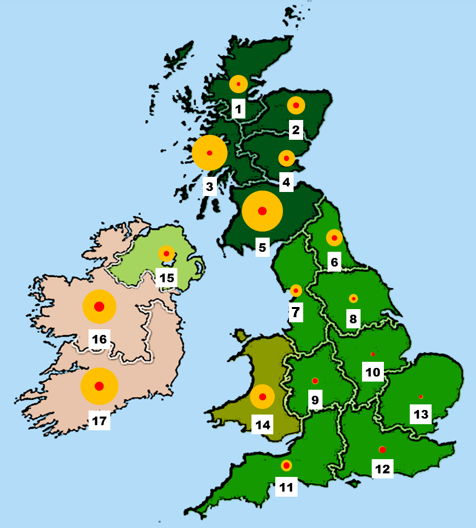
It is quite common for species with similar timber properties to be lumped into a commercial “species combination” for trade (the species are not differentiated – they are sold and processed together).
“British spruce” is an example of a species combination. EN14081-1 (and the UK National Annex of EN13556) list it with marking code WPCS. It consists of two spruce species:
- Picea sitchensis (“Sitka spruce”)
- Picea abies (“Norway spruce”)
It is not, strictly, limited by definition to timber grown in the British Isles (UK and Ireland) but this is what is is intended for, and why the species combination name implies the origin.
Over the total area of spruce forests in the British Isles, approximately 92% of these forests are comprised of Sitka spruce, with the remaining 8% consisting of Norway spruce. The exact mix depends on the location, but you can be pretty sure that when you buy “British spruce” what you mostly have is Sitka spruce, with some Norway spruce mixed in. It is not known how the species compare when grown in the British Isles (other than knowing that they are have very similar properties) but David Gil-Moreno’s PhD project is shedding some light on that.
There is potential for other spruce species to be grown for timber in the British Isles (we are currently researching Serbian spruce, Picea omorika) but these would not be included in “British spruce”, despite being spruce grown in Britain – the species combination is, specifically, Sitka spruce and Norway spruce.
The proportion of the spruce forest by region is shown below. The amount of Norway spruce is indicated by the area of the red circle and the amount of Sitka spruce is indicated by the surrounding area of yellow.
|
Total |
% Sitka |
||||
| Country | Region |
Key |
1000 ha |
||
| UK | Scotland | North |
1 |
47.0 |
96% |
| North East |
2 |
47.0 |
89% |
||
| West |
3 |
180.0 |
98% |
||
|
East |
4 | 39.0 |
90% |
||
| South |
5 |
235.0 |
96% |
||
| England |
North East |
6 | 41.2 |
89% |
|
|
North West |
7 |
21.6 |
87% |
||
| Yorkshire & Humber |
8 |
11.9 |
83% |
||
| West Midlands |
9 |
6.2 |
34% |
||
| East Midlands |
10 |
2.1 | 10% | ||
| South West |
11 |
18.2 |
68% |
||
| South East & London |
12 |
7.0 |
11% |
||
| East |
13 |
2.1 |
19% |
||
| Wales | Wales |
14 |
84.3 |
92% |
|
| NI | Northern Ireland |
15 |
40.0 |
90% |
|
| Éire | Éire North |
16 |
162.5 |
91% |
|
|
Éire South |
17 |
198.3 |
94% |
Sources:
- Forestry Commission, 2011. National Forest Inventory. Forestry Commission, Edinburgh, UK, 58 p. ISBN 0 85538 602 9
- Forest Service, 2013. The Second National Forest Inventory – Republic of Ireland – Results. Forest Service of the Department of Agriculture, Food and the Marine, Co. Wexford, Ireland, 278 p. ISBN 978-1-4064-2809-4
- NI Forest Service, 2013. Woodland Register. Northern Ireland Forest Service of the Department of Agriculture and Rural Development, Belfast, UK.


Picea orientalis is a minor species with a potential commercial applications. Any work on the timber properties of this?
Cheers
Ben
Hi Ben,
We have seen Picea orientalis but it is not one of the species on our list at the moment, which has been governed by what is available to us and grown in the UK.
We have other projects currently looking at different species grown in the UK which including the PhD mentioned above which is looking at Norway spruce, western red cedar, western hemlock and noble fir, and a separate project looking at Serbian spruce, grand fir, European silver fir, Pacific silver fir, Japanese cedar, sycamore and birch. Updates on these other species projects can be found in our blog.